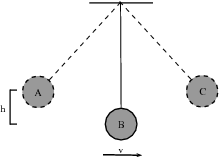| << Chapter < Page | Chapter >> Page > |
In the absence of friction , the work done on an object by a system is equal to the energy gained by the object.
In the presence of friction , only some of the energy lost by the system is transferred to useful energy. The rest is lost to friction.
In the example of a falling mass the potential energy is known as gravitational potential energy as it is the gravitational force exerted by the earth which causes the mass to accelerate towards the ground. The gravitational field of the earth is what does the work in this case.
Another example is a rubber-band. In order to stretch a rubber-band we have to do work on it. This means we transfer energy to the rubber-band andit gains potential energy. This potential energy is called elastic potential energy . Once released, the rubber-band begins to move and elastic potential energy is transferred into kinetic energy.
Some of these forms of energy will be studied in later chapters.
Energy can be taken from almost anywhere. Power plants use many different types of energy sources, including oil, coal, nuclear, biomass (organic gases), wind, solar, geothermal (the heat from the earth's rocks is very hot underground and is used to turn water to steam), tidal and hydroelectric (waterfalls). Most power stations work by using steam to turn turbines which then drive generators and create an electric current.
Most of these sources are dependant upon the sun's energy, because without it we would not have weather for wind and tides. The sunis also responsible for growing plants which decompose into fossil fuels like oil and coal. All these sources can be put under 2headings, renewable and non-renewable. Renewable sources are sources which will not run out, like solar energy and wind power.Non-renewable sources are ones which will run out eventually, like oil and coal.
It is important that we learn to appreciate conservation in situations like this. The planet has a number of linked systemsand if we don't appreciate the long-term consequences of our actions we run the risk of doing damage now that we will onlysuffer from in many years time.
Investigate two types of renewable and two types of non-renewable energy resources, listing advantages and disadvantages of each type. Write up the results as a short report.

| position | |||
| A | 50 J | ||
| B | 30 J | ||
| C | |||
| D | 10 J | ||
| E | |||
| F | |||
| G |


Notification Switch
Would you like to follow the 'Siyavula textbooks: grade 12 physical science' conversation and receive update notifications?